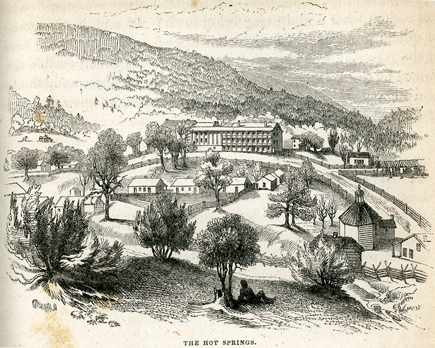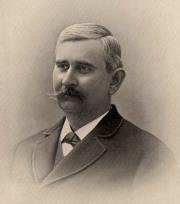Hot Springs
Bath County, Virginia
The beneficial effects of hot spouts topically applied are so miraculous in many painful and obstinate complaints that words cannot adequately describe them, therefore the prisoners of pain are strongly recommended to expose their rheumatic joints, gouty toes and enlarged livers to the comfortable outpourings of these healing streams. John R. Page

The Hot Springs resort as drawn by Porte Crayon in 1857. The large hotel, the Homestead, was built by Dr. Thomas Goode in 1846. {1}
William Burke on the Hot Springs.
The Hot Springs are located in Bath County, Virginia, five miles distant from Warm Springs. Dr. Burke’s book, The Mineral Springs of Western Virginia, reported that the accommodations were suitable for 150 people and the meals were “excellent and plentiful, and served with neatness and comfort.” The property was owned by Dr. Thomas Goode who also served as the resident physician and supervisor of activities at the Hot Springs. He seemed to have a “deficiency in the art of pleasing” and was described as supercilious, high-toned, and rude. He also was the target of “complaints long, loud, and reiterated” because of his charges for board and baths. Nevertheless, Dr. Burke also stated that Goode was a well-bred gentleman, a physician of high standing based on his talent and experience, a man who would offer honest and reliable advice, and a doctor whose great goal was the physical improvement of his patients.
Burke’s Recommendations for Using the Waters at Hot Springs.
Dr. Burke urged caution at the Hot Springs not because of an excess amount of nitrogen gas like the nearby Warm Springs, but because of the high temperature of the water, “as the Hot bath is decidedly stimulating to the human system, it is always proper, if not absolutely necessary, to obtain the best advice before we have recourse to so powerful an agent.”
Thomas Goode was born in 1787 to Colonel Samuel Goode who was a member of the U.S. Congress from 1799-1801. Thomas moved to Bath County, Virginia, in 1833 and bought the Hot Springs which he built up with his wisdom and energy. He was the father of at least seven daughters and two sons, an enthusiastic politician, and buried near the Hot Springs Hotel. {Goode, 63, 122}
Six baths, each with its own spring, had temperatures ranging from 98-106 degrees. Convinced of the “high curative power” of the springs and of Dr. Goode’s skill, Dr. Burke included ten testimonial letters from patients and doctors written to Dr. Goode. These letters, nine of which were taken from Thomas Goode’s book printed in 1846, The Invalid’s Guide to the Virginia Hot Springs, claimed the Hot Springs were useful in curing or aiding patients with chronic diarrhea, painful menstruation, hemorrhoids, inflammatory rheumatism, skin ulcers, stomach and liver pain, lead poisoning, and paralysis. One of the letters that Dr. Burke included in his volume was written by H. Howard, M.D., a professor at the University of Virginia from 1839 to 1867. In late 1841 Dr. Howard wrote that for ten years, which included time at the University of Virginia as well as Baltimore, he had been sending all his patients with chronic diarrhea or painful menstruation to the Hot Springs. He claimed good results as long as the patients followed a prescribed regimen and had the advice of a physician.
I have been at the Hot Springs for six entire seasons, and have watched their effects on several thousand invalids, with all the interest which ownership could excite. Dr. Thomas Goode
Dr. Burke’s extensive quotes from Goode’s book described two baths with three to four inch columns of water falling for six feet that were beneficial to rheumatic patients. Another bath was so large that it could be used for swimming both by the sick and for the healthy simply for pleasure. Dr. Goode claimed, “These waters taken internally, are anti-acid, mildly aperients, and freely diuretic and diaphoretic. But when used as a general bath, their effects are great, and excel all expectation. They equalize an unbalanced circulation, and thereby restore the different important parts of the system, … and often relieve, in a short time, excruciating pain caused by palpable and long standing disease of some vital organ.” {Burke, p. 80}
W. B. Towles’ 1885 Case Book {3} for the Hot Springs includes entries for people from at least 13 different states including Illinois, New York, and Georgia. One was for a government official who had bathed at foreign resorts before coming to the Virginia Hot Springs and was a confirmed dyspeptic. Towles’ diagnosis included malarial neuralgia, and he ordered the man to spend 15 minutes in the hot spout alternating with 8 minutes in the boiler. The account indicates a $7.50 charge for quinine, smaller charges for med, and a dollar fee for cupping.
This image of Dr. William Beverly Towles shows him several years before he compiled his 1885 Case Book. He was a Professor of Anatomy at the University of Virginia School of Medicine from 1885 until his death in 1893.{4}
Documents from the Small Special Collections Library, University of Virginia:
- Alexander Dick, 1808: A Scottish accountant, Dick describes the various temperatures of the springs and how a patient is laid between blankets after spending 15 or 20 in the 106 degree spring water.
- Letter from John McLaughlin to Mrs. Mary O. McLaughlin, 1814: Mr. McLaughlin writes that he and two of his companions are better than they have been for several months.
- Letter from Dr. Henry Howard, 1841: Dr. Howard gives a masterful reply in response to Dr. Goode’s request for his opinion about the springs.
- Letter from John Minor to Alexander Garrett, 1848: Minor writes of a sore mouth, teeth jumping out of their sockets, being cooped up in a little room only 10 feet square, feeling weaker than ever, and dreading when the baths will cause a “disgorgement” of his liver.
- Circuit Court of Albemarle, [1868?]: Dr. Goode died in 1858. The Hot Springs were open as a watering place until August 1863 and then offered for sale. This suit contests the sale which was complicated by debts, the war, and the valuation of Confederate money.
- An Account of the Hot Springs, Bath County, Va. …, 1873: This account is by Dr. James L. Cabell, the resident physician at the Hot Springs and the senior faculty member at the University of Virginia.
- Concerning Hot Springs of Virginia by John R. Page, 1894: Page writes a letter extolling the springs and particularly the hot spouts that are “miraculous in many painful and obstinate complaints.”
- Letter from G. W. Banks, 1897: Banks writes that all people with syphilis go to hot springs as the hot water soaks the mercury into them. He mentions this as a town newspaper has given the names of several people traveling to Hot Springs, Arkansas.
Additional Information:
- National Register of Historic Places Nomination Form: This detailed form for the Hot Springs is dated June 1979. It includes the history and significance of the springs, location, description of buildings, maps, and a bibliography.
- National Register of Historic Places: The National Register has a brief summary of places in Bath County, Virginia.
- The Homestead: The current owner’s official Web site gives a history of the resort.
- The Homestead: A Brief History: It is called brief, but this document contains a lot of information.
- Hot Springs, West Virginia, Geo-Heat Center Bulletin, May 1996: The Bulletin explains the resort’s history from its early days up through its development into the mid 1990s. It includes its use as a Confederate hospital and a World War II facility for Japanese diplomats. Illustrations are included.
- Drawings of Porte Crayon, the pen name for David Hunter Strother: The site describes Strother’s contributions as a graphic artist and writer.
- Library of Congress Prints & Photographs Online Catalog: Search for Hot Springs Virginia and see dozens of images of the springs, many from 1946.
- Thomas Jefferson’s Notes on the State of Virginia: In Jefferson’s section titled “Productions mineral, vegetable and animal,” he includes information about medicinal springs, one of which is Hot Springs.
Image Credits:
- {1} David Hunter Strother, Virginia Illustrated: Containing a Visit to the Virginian Canaan, and the Adventures of Porte Crayon [pseud.] and His Cousins, New York: Harper & Brothers, 1857: p. 135. University of Virginia Library.
- {2} Merritt T. Cooke Memorial Virginia Print Collection, 1857-1907, Accession #9408, Special Collections, University of Virginia Library.
- {3} W. B. Towles Medical Case Book, 1885, Accession #11532, Special Collections, University of Virginia Library.
- {4} University of Virginia Visual History Collection, Image Filename: prints08141. Accessed July 21, 2009.
Sources:
- William Burke, The Mineral Springs of Western Virginia, New York: Wiley and Putnam, 1846.
- G. Brown Goode, Virginia Cousins: a Study of the Ancestry and Posterity of John Goode of Whitby, Richmond, Va.: J. W. Randolph & English, 1887.
![]() Previous: Fauquier White Sulphur Springs / Next: Red Sulphur Springs
Previous: Fauquier White Sulphur Springs / Next: Red Sulphur Springs ![]()
-300x190.jpg)

